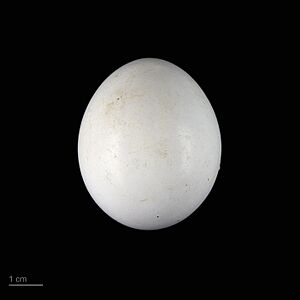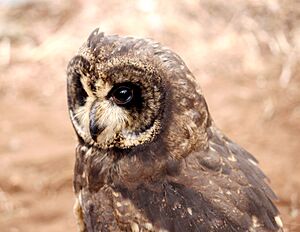Marsh owl facts for kids
The marsh owl (Asio capensis) is a cool type of owl that lives in many parts of the world. It's a medium-sized bird belonging to the Strigidae family, which includes many well-known owls.
Quick facts for kids Marsh owl |
|
|---|---|
 |
|
| Conservation status | |
| Scientific classification | |
| Genus: |
Asio
|
| Species: |
capensis
|
Contents
What Does a Marsh Owl Look Like?
Marsh owls are medium-sized birds, usually dark brown. They have a head that looks a bit like a pumpkin. They also have small "ear" tufts, which are just feathers, not actual ears!
Their face is light brown with a dark brown edge. They have dark brown areas around their eyes, which are also dark brown. Their tail is dark brown with light brown stripes and a white tip. Their legs and toes are covered in light brown feathers, but their dark claws are bare.
Male marsh owls are often a bit lighter in color than females. These owls are about 31–38 cm long. They weigh between 225 and 485 grams, which is about the same as a can of soup!
Where Do Marsh Owls Live?
Marsh owls love open spaces like grasslands and marshlands. They also like areas with short bushes, especially near wet places like vleis (wetlands) or dams.
These owls usually build their nests on the ground. Sometimes, they move away from areas during droughts. Their favorite homes are often in danger because of farming and too much animal grazing.
Marsh Owl Reproduction
Marsh owls usually nest when the wet season is ending or the dry season is starting. They are monogamous, meaning they have one partner. They also tend to be territorial, protecting their space.
Sometimes, they nest in small groups. Their territory can be quite large, about 0.8 to 2.5 square kilometers. However, hunting areas of different owl pairs might overlap.
The nest is usually a hollow spot in a patch of grass. The owls pull grass or shrubs over the top to create a roof. They line the bottom of the nest with dry leaves.
The female owl lays 2 to 6 white eggs over a few days. She sits on the eggs for about 27–28 days to keep them warm. During this time, her partner brings her food.
After the chicks hatch, they stay in the nest for about 18 days. They learn to fly when they are 29–35 days old. By 70 days, they have all their adult feathers.
Behavior and Diet
You'll usually find marsh owls alone or in pairs. They are mostly active at night. However, sometimes you might see them flying around in the early morning or late afternoon.
Marsh owls mainly eat small rodents, insects, and other small animals. Their diet includes mice, voles, rats, and shrews. They also eat young hares, bats, small birds like ducks and doves, frogs, lizards, scorpions, beetles, and grasshoppers.
Where Are Marsh Owls Found?
Marsh owls live in different parts of the world. They are common in the grasslands of southern Africa. You can find them in the northern parts of South Africa, all the way down to the Eastern Cape province.
They also live in Zimbabwe on the Mashonaland plateau. You can find them in the Makgadikgadi lacustrine depression in Botswana too.
Marsh owls have also been seen on the floodplains of the Namibian coast. There are also small groups of them in Morocco and Madagascar.
Protecting Marsh Owls
Marsh owls are not currently listed as endangered or vulnerable. However, their numbers are going down. This is mainly because their homes are being destroyed as cities grow.
Marsh owls often breed during the winter months. This is also when veld fires (grassland fires) happen. They nest on the ground in places like marshes, savannas, and grasslands.
Farmers sometimes burn veld to help new plants grow for animals to eat. They also do it to stop unwanted plants from growing and to control ticks. While these fires can be good for the grassland ecosystem, they should only happen about every five years, not every year.
Burning the veld too often or carelessly takes away the homes of wildlife. For marsh owls, this has a big impact on their breeding and how many of them there are.





